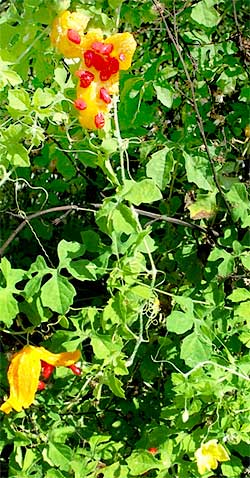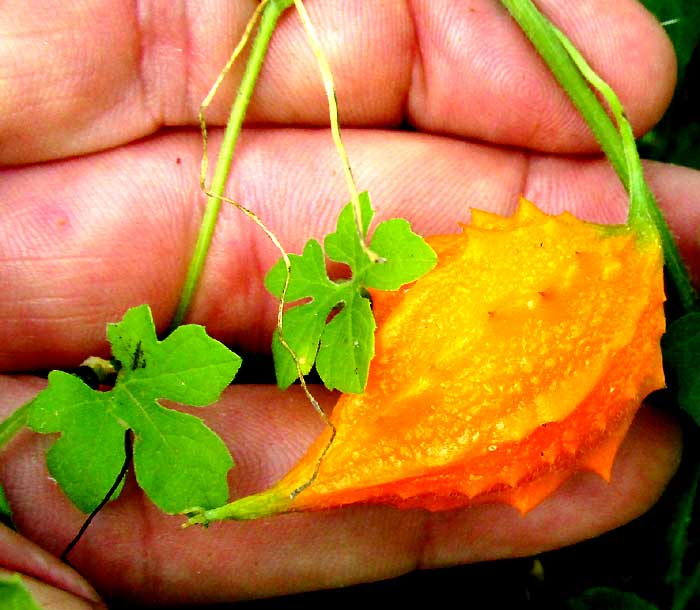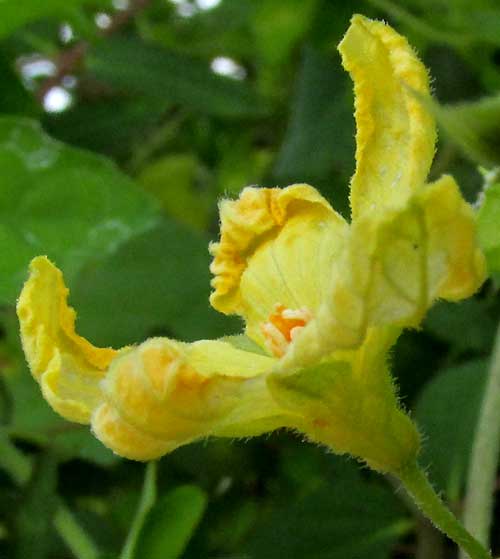Excerpts from Jim Conrad's
Naturalist Newsletter
from the November 20, 2006 Newsletter issued from Diego Nuñez's office above Restaurante "Isla Contoy," Río Lagartos, on the Yucatan Peninsula's northern coast (~N21.60°, ~W88.16°), Yucatán state, MÉXICO
BALSAM-PEARS
It was quite something a few years ago when I was a hermit in Mississippi occasionally passing entire months not saying a single word to anyone -- but being connected to the Internet by wires strung through the trees. As I developed the EarthFoot.Org ecotour site I found myself in daily communication with small-scale ecotour operators all over the world. One of my favorites, someone with whom I exchanged letters almost daily for years, until he died, was a young gay man in Bangladesh, Rengyu.
 One day he told me that since I tended to sauté so many homegrown vegetables during morning campfire-breakfasts I absolutely needed to grow "Bitter Gourd." Yes they were bitter but if sautéed correctly with other vegetables they could lend a homey, philosophical flavor pleasing not only to the palate but also to the soul. At the right you see a vine that grows here that's very closely related to and looks like Rengyu's Bitter Gourd, and which grows as a weed throughout the Yucatan
One day he told me that since I tended to sauté so many homegrown vegetables during morning campfire-breakfasts I absolutely needed to grow "Bitter Gourd." Yes they were bitter but if sautéed correctly with other vegetables they could lend a homey, philosophical flavor pleasing not only to the palate but also to the soul. At the right you see a vine that grows here that's very closely related to and looks like Rengyu's Bitter Gourd, and which grows as a weed throughout the Yucatan
That image shows Balsam-pear, MOMORDICA CHARANTIA, a member of the Cucumber Family. Its yellow flower, visible in the image at the lower right, is similar to that of a cucumber vine. Its pointed but otherwise egg-shaped fruit is brightly yellow-orange and you can see that at maturity it splits open revealing vividly red, glistening seeds. The picture was taken right down the street from where I'm staying now. I've found Balsam-pear growing as a weed throughout the Yucatan.
I find our wild Yucatan fruits disappointingly not-so-bitter. In fact, they are so bland that I don't bother picking them even when I can prepare my morning campfires.
Still, the plant with is eye-catching fruit is worth knowing simply because it's such a conspicuous part of the flora. Of course it's an introduced weed here, an invasive originating in the Old World tropics.
My books report that in the Yucatan people traditionally have used either the root or the leaves for preparing an aphrodisiac, the leaves for a potion against intestinal worms, and the fruit in a cataplasm against itch, sores and burns.
Issued on January 2, 2020 from the forest just west of Tepakán; elev. ~9m (~30 ft), N21.053°, W89.052°; north-central Yucatán state, MÉXICO
MORE PICTURES
Nowadays I have a better camera than back in 2006, so here are some more detailed pictures. Here's an unopened fruit:

And a mature fruit displaying its red, aril-covered seeds:

And a male flower:
